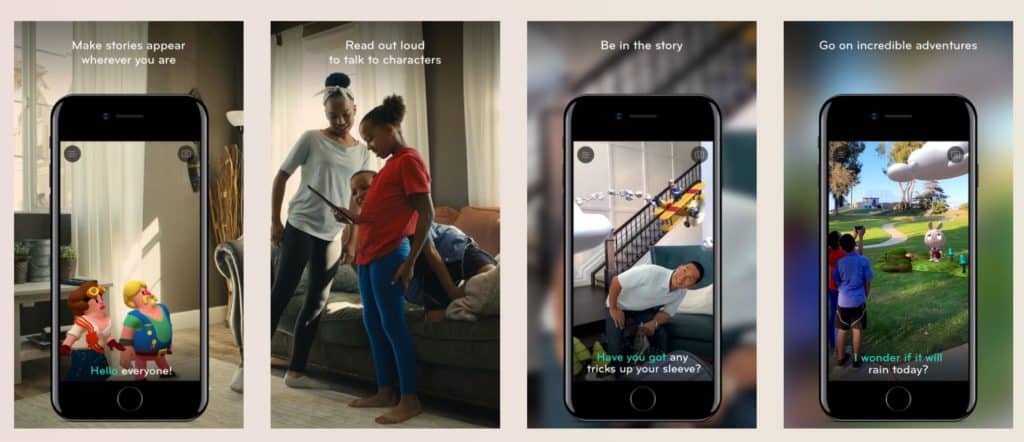Take a look at Chris Milk’s recent interview with The Wrap on Storytelling in AR and VR. The innovative director and immersive artist is the CEO of the VR tech and entertainment company, Within. Other companies have come and gone but Within continues to be at the forefront of the immersive tech revolution.
Recently, Chris Milk been focusing on the company’s first AR app, Wonderscope, which relies on Apple’s ARKit. Wonderscope includes 8-12 minute interactive augmented reality stories that are more than simple digital projections.
In conjunction with the release of the app, Within has been working to
. . . get L.A. schoolchildren more familiar with AR, partnering with L.A. Public Libraries and L.A.’s BEST Afterschool Enrichment Program to put iPads and Wonderscope in the hands of students across the city.
Here’s the intro video on Wonderscope:
What really striking in the video is when you consider what will happen when we no longer need to hold a device in our hands. Once we have storytelling in AR and VR through our everyday eyewear.
Our stories will populate – and perhaps even overtake – our living rooms and bedrooms. And they’ll be present in our retail and work environments.
Who knows? We might even let them in the classroom (as if we’ll have a choice).
Storytelling in AR and VR
It’s worth reading the interview with Chris Milk in full, but we’ll share one section here.
I don’t think the final form of storytelling in these mediums is going to be one of watching. I don’t think that’s where this is going. These are mediums of living the story, not observing the story. We witness stories our entire lives. All the storytelling mediums we know and love are ones where an author recounts a tale and we bare witness to that tale.
What gets me so excited about these immersive mediums is it feels like we’re crossing the threshold from stories we witnessed to stories we live as our own. That is the true promise of these immersive mediums, and you’re just starting to see that bubble up. Wonderscope is certainly an example of this. These kids experience these stories as characters in the story and walk away with the memory of a story that’s their own, and not a piece of media that they consumed. I’m not that worried about looking in the right direction, because that’s not the point of this medium. You’re a part of these stories and they will adapt and breath in the same way you adapt and breath.
When you live the story, there’s no longer an issue of looking in the right direction. You’ll engage with the characters – and ultimately, they’ll engage with you. We already see the beginnings of that in the unforgettable Wolves in the Walls experience. Here the character, Lucy, treats you as a character in her own story.
The Wonderscope App: A Step Toward the Future

Right now, AR is still limited and that’s where Within’s Wonderscope app comes in. It acknowledges that you’re going to be holding a phone or iPad in your hands.
You’re holding out an iPad in front of you, you’re facing a story either on a flat surface in front of you on the floor or on the table or we’re having it float in space in the room. We call it Wonderscope because it is a scope and you’re seeing a story that’s basically invisible without looking through it. That’s different than future forms of augmented reality where you can conceivably wear it on your head, map things onto the walls, ceilings and take over everything. We will get there, but we’re not there yet.
And what happens when we get there? When storytelling in AR and VR is in our eyewear? You’ll no longer reach for the book or the remote control. The characters will show up in your room. Sit on the sofa beside you. Follow you around the house to your kitchen.
Immersive stories might even come with new labels. Perhaps they’ll be rated according to how often they appear. In some, a virtual character may only come once a week, or when summoned. Other characters might appear beside you multiple times a day, unscheduled and unexpected (yes, much like our social media is now).
But instead of us watching them, the characters will interact with us. Pulling us in – as Lucy does – as characters in their stories. And of course, AI will play an increasing role in driving their actions. We’ll want unscripted characters, characters that surprise us, challenge us, even transform us.
Watching a story unfold while holding up an iPad is an amazing experience. But this is only the beginning of the remarkable ways that storytelling will reinvent itself through AR and VR.
Emory Craig is a writer, speaker, and consultant specializing in virtual reality (VR) and artificial intelligence (AI) with a rich background in art, new media, and higher education. A sought-after speaker at international conferences, he shares his unique insights on innovation and collaborates with universities, nonprofits, businesses, and international organizations to develop transformative initiatives in XR, AI, and digital ethics. Passionate about harnessing the potential of cutting-edge technologies, he explores the ethical ramifications of blending the real with the virtual, sparking meaningful conversations about the future of human experience in an increasingly interconnected world.

